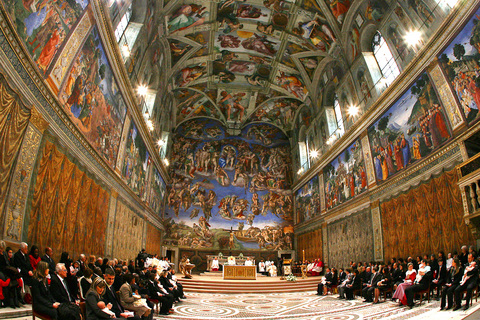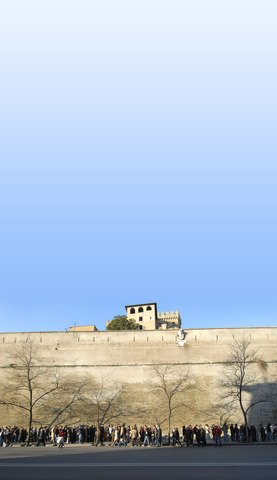Visitors to the Vatican are getting a heads-up that nothing is eternal — at least when it comes to the Holy See's museums. Admission prices just went up by a euro to 13 euros, or about US$17.15 at US$1.32 to the euro, and opening hours have shrunk for visitors not affiliated with organized tour groups.
Until very recently, doors opened at 8:45am. Under the new rules, which went into effect last month, Vatican-approved tour groups with reservations will still be able to get in at that early hour, but individual visitors must wait until 10am.
Vatican officials say the shorter hours are part of a plan to control overcrowding by phasing in a mandatory reservation system over the next year for all visitors, whether they are on a group tour or not. Tour groups are being given priority now, they say, because they are easier to manage.

PHOTO: AP
But some in the Italian tourism industry say that when you add the time waiting in line — which can be two hours or longer in the summer — and the fact that tickets are sold only until 12:30pm in the off season and 3:30pm in high season, visitors not part of a group may have barely enough time to see anything at all.
And of course there is much to see: Michelangelo's Sistine Chapel, for instance, and the rooms Raphael painted for Pope Julius II. These treasures of Western art are, for many tourists, a principal reason to visit Rome in the first place.
But the number of visitors to the Vatican has nearly doubled in the last 10 years, hitting a high of 4.2 million in 2006, and has resulted in the overcrowding of a structure originally built to accommodate a Renaissance papal court, not up to 20,000 visitors at a time shuffling around one another.

PHOTO: NY TIMES NEWS SERVICE
Between enormous tour groups and rowdy school-trippers, a visit to the Vatican Museums can become "more of a traumatic than an artistic experience for tourists," said Paola, one of several guides who were interviewed and who asked that their full names not be used for fear of offending the Vatican.
The changes come as many Italian cultural sites take measures to control overcrowding.
Before a booking system went into effect at the Uffizi Gallery in Florence, the lines at the entrance rivaled those at the Vatican. While the Uffizi caps at 900 the number of visitors who can be inside at one time, some 1.5 million visitors managed to tour the galleries last year. Once a major restructuring project is completed in four or five years, the number of people allowed in at one time is expected to increase significantly.
"We're trying to make the structure more functional," said Cristina Acidini, who oversees Florence's state museums.
The Colosseum, too, has a booking service, but because all visitors have to pass through security checkpoints, with 3.9 million visitors a year, lines are inevitable. "It's still pretty fast," said Rossella Rea, the archaeologist in charge of the monument.
But it could be faster, so a new entrance point is being developed at the eastern end of the Colosseum. If financing allows, a now-closed section of the main floor's walkway will be restored this year, so visitors will have more space to spread out. Granted, the Roman amphitheater is large (it once held 80,000 ancient Romans), but tour groups still manage to trip over one another. "It's not that it's a delicate monument that's going to wear out," Rea said. "It's more a question of directing pedestrian traffic inside."
But at the Vatican, critics worry that the shorter hours will lengthen the lines, which on some days reach about 2.5km around Vatican City's walls to the colonnade of St. Peter's Square. Now, people will still line up, but "they won't have the certainty that they'll get in before the museums close," said one American guide who asked not to be named.
Still, something must be done about the overcrowding, said Francesco Buranelli, the director of the Vatican Museums. "The snaking line is under everyone's eyes; it's jaw-dropping, even though it does move pretty fast," he said, notwithstanding the increased security measures at the entrance after Sept. 11, 2001.
The new hours, he said, were the first step toward the mandatory reservation system that will go into effect in January and that museum officials said will allow them to spread out visitors during the day. For now, favoring tour operators, who bring in more than a third of total visitors, is seen as a "convenient choice to help the museums through this transition," Buranelli said. (Museum administrators say they do not plan to cap the number of visitors who are inside the museums at the same time.)
Buranelli's explanation is little consolation to Fabio, another guide, who anticipates a "rough year ahead," with lower earnings and more complaints from his clients. "I hope I'll be able to convince them to see other museums, instead," he said.
He and others wonder why museum officials are not opting for longer hours. They cite the success of Italy's state museums, which remain open until 7pm, getting about a third of the visits in the afternoon and evening, according to the Culture Ministry's statistics office. At the Metropolitan Museum of Art in New York, some 600,000 of its 4.3 million visitors last year chose to come on Friday and Saturday evenings, either to see the collection or to attend a special event.
But Buranelli says that studies he commissioned indicate that most visitors concentrate their visits between 10am and 1pm and, with more than 6.5km of corridors to safeguard and dozens of guards and custodians on the payroll, the costs of keeping the museums open in the evening would not be offset by ticket sales. "For tourists, culture is a daytime activity," he said.
Some guides snidely suggest that the Vatican already makes a healthy profit from the two-hour private tours that take place once the museum is closed and that with the new system it will make even more money. Current prices start at 2,500 euros for a group of 1 to 30 people, 3,500 euros for 31 to 60 people, and 5,000 euros for 61 to 100 people, plus the per-person cost of a ticket. They also grumble that the new system gives an advantage to the Vatican's in-house guides, who have guaranteed access.
The Vatican Museums were once practically the only major cultural institutions on the Italian peninsula open after lunch. A dozen or so years ago, most state museums and archaeological areas stayed open only until 2pm, and museum shops peddled only postcards and catalogs, when they existed at all. "There was an entrenched feeling, residual thinking from Catholic and Marxist philosophy, that making money from culture was either impossible or a sin," said Daniel Berger, an Italian Culture Ministry consultant.
Then came Alberto Ronchey, who was culture minister from 1992 to 1994 and helped push through a 1993 reform of the state museum sector that lengthened opening hours and allowed private companies to operate services like ticketing, bookstores and restaurants.
"Cooperation between the private and public sector has improved the situation enormously, both from a qualitative and quantitative point of view," said Albino Ruberti, managing director of Zetema, which provides services to Rome's civic museum.
Despite the inroads made by the Ronchey law and growing museum attendance, experts say the full economic potential of cultural tourism in Italy has not been fully exploited. Culture Minister Francesco Rutelli said in a recent interview that he had formed a committee to examine the legislation that determined how museums were run, and promised a "radical reform" by the summer.
Unlike many other cultural institutions, the Vatican Museums understood the importance of merchandising early on. They were among the first museums to have audio guides, and a restaurant has operated within its walls since 1975. It has also been selling guidebooks and monographs on its collections for some 20 years, recently branching out into new lines, like the high-end Vatican Library Collection, which includes merchandise like reproductions of documents from the Vatican's archives and facsimiles of papal seals.
But when it comes to opening hours, some critics say that the usually forward-looking Vatican Museums seem to be regressing.
"There are always complaints when you have change," Buranelli said. But in the long run, the only thing that matters, he said, was to "resolve the overcrowding issue."

That US assistance was a model for Taiwan’s spectacular development success was early recognized by policymakers and analysts. In a report to the US Congress for the fiscal year 1962, former President John F. Kennedy noted Taiwan’s “rapid economic growth,” was “producing a substantial net gain in living.” Kennedy had a stake in Taiwan’s achievements and the US’ official development assistance (ODA) in general: In September 1961, his entreaty to make the 1960s a “decade of development,” and an accompanying proposal for dedicated legislation to this end, had been formalized by congressional passage of the Foreign Assistance Act. Two

Despite the intense sunshine, we were hardly breaking a sweat as we cruised along the flat, dedicated bike lane, well protected from the heat by a canopy of trees. The electric assist on the bikes likely made a difference, too. Far removed from the bustle and noise of the Taichung traffic, we admired the serene rural scenery, making our way over rivers, alongside rice paddies and through pear orchards. Our route for the day covered two bike paths that connect in Fengyuan District (豐原) and are best done together. The Hou-Feng Bike Path (后豐鐵馬道) runs southward from Houli District (后里) while the

March 31 to April 6 On May 13, 1950, National Taiwan University Hospital otolaryngologist Su You-peng (蘇友鵬) was summoned to the director’s office. He thought someone had complained about him practicing the violin at night, but when he entered the room, he knew something was terribly wrong. He saw several burly men who appeared to be government secret agents, and three other resident doctors: internist Hsu Chiang (許強), dermatologist Hu Pao-chen (胡寶珍) and ophthalmologist Hu Hsin-lin (胡鑫麟). They were handcuffed, herded onto two jeeps and taken to the Secrecy Bureau (保密局) for questioning. Su was still in his doctor’s robes at

Mirror mirror on the wall, what’s the fairest Disney live-action remake of them all? Wait, mirror. Hold on a second. Maybe choosing from the likes of Alice in Wonderland (2010), Mulan (2020) and The Lion King (2019) isn’t such a good idea. Mirror, on second thought, what’s on Netflix? Even the most devoted fans would have to acknowledge that these have not been the most illustrious illustrations of Disney magic. At their best (Pete’s Dragon? Cinderella?) they breathe life into old classics that could use a little updating. At their worst, well, blue Will Smith. Given the rapacious rate of remakes in modern